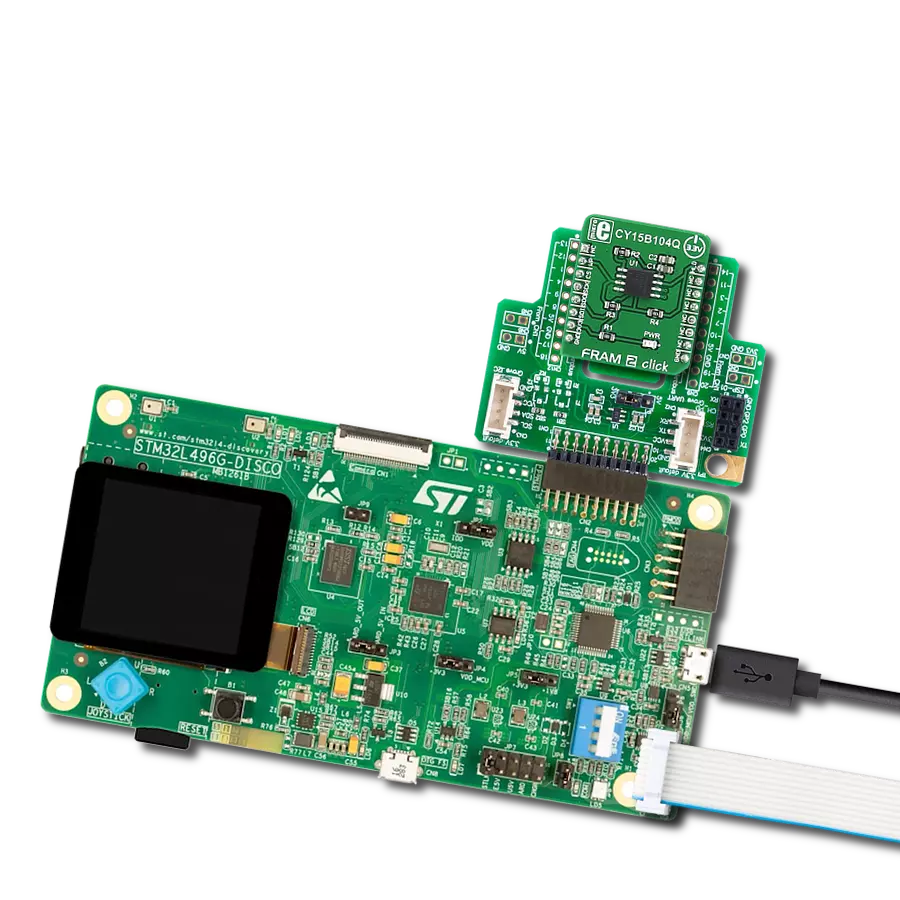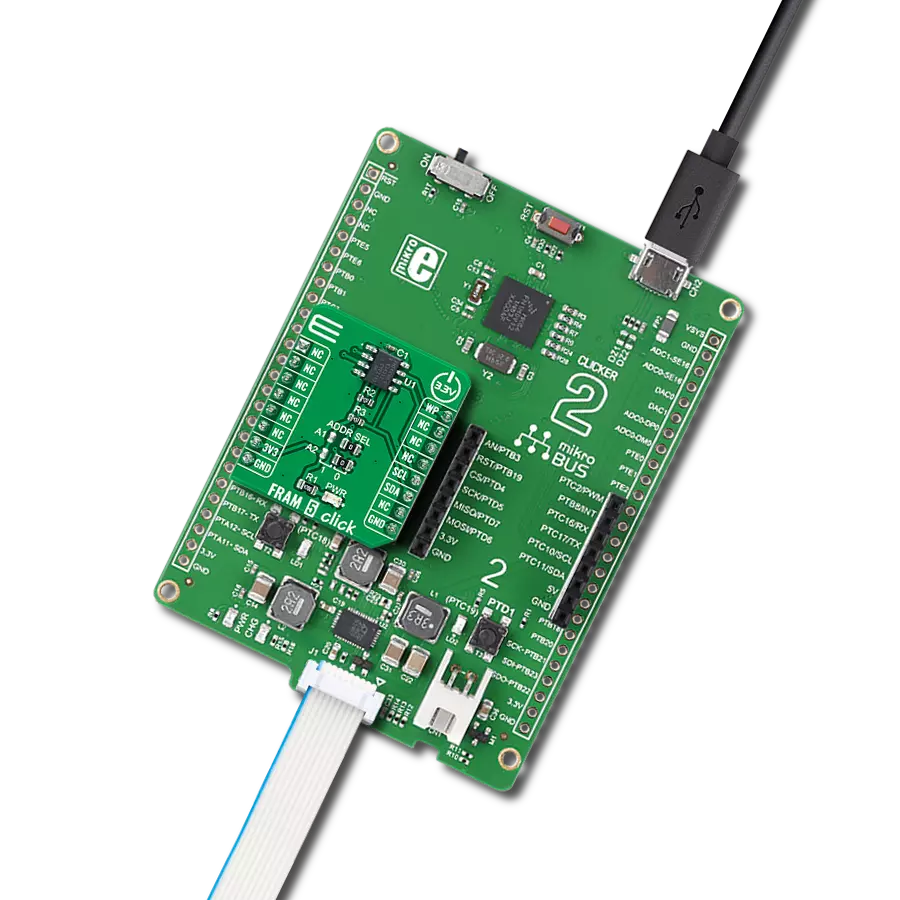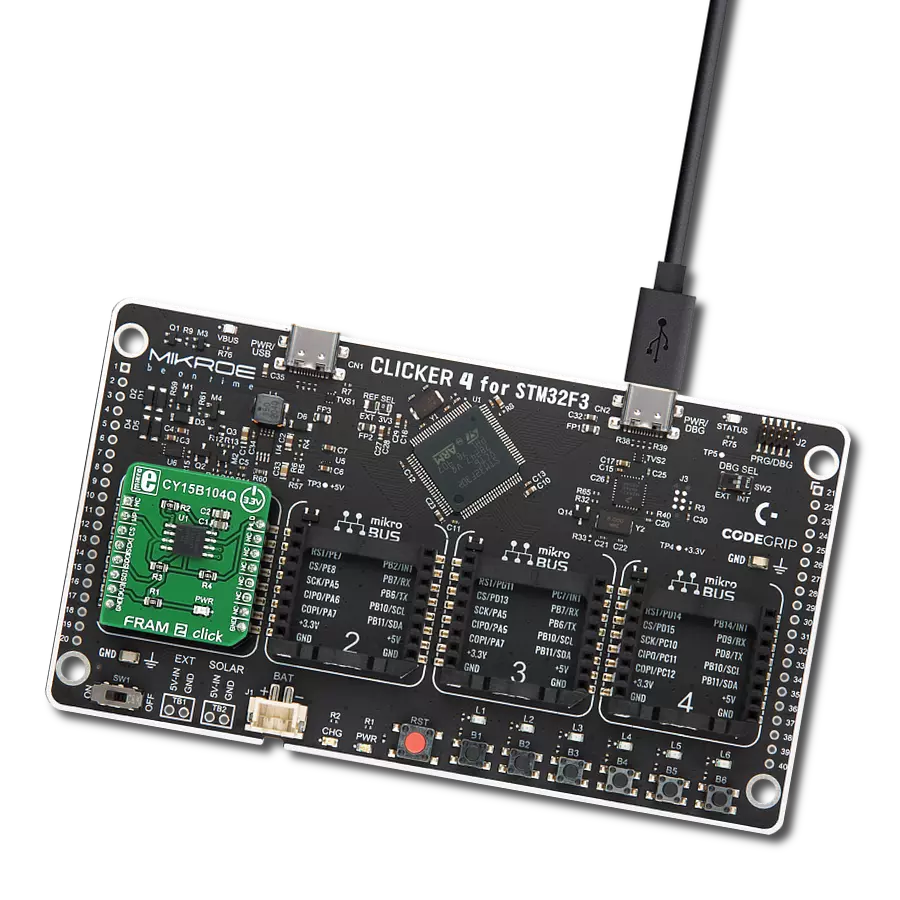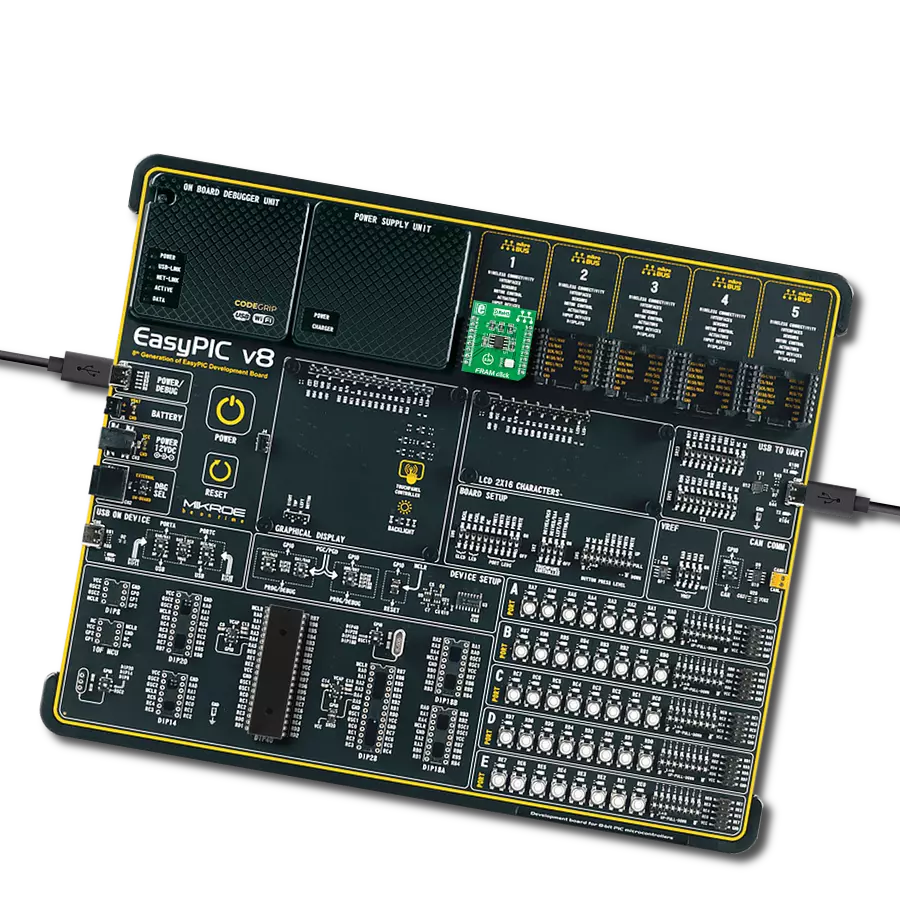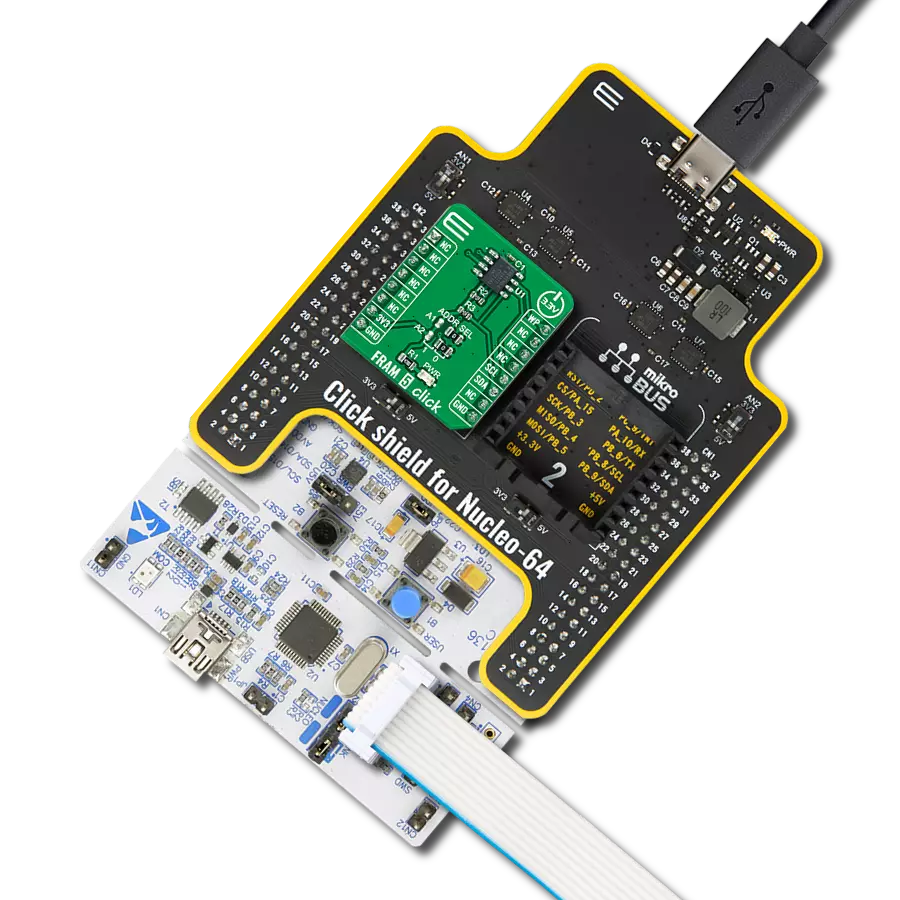Unlock the true potential of your engineering solution with the advanced capabilities of FRAM memory
A
A
Hardware Overview
How does it work?
FRAM 6 Click is based on the CY15B102Q, a 2Mbit ferroelectric random access memory (F-RAM) logically organized as 262,144×8 bits and accessed using an industry-standard serial peripheral interface from Infineon, now part of Infineon. The functional operation of the F-RAM is similar to serial flash and serial EEPROMs, where the significant difference between the CY15B102Q and a serial flash or EEPROM represents the F-RAM's superior write performance, high endurance, and low power consumption. That's why this Click board™ is ideal for nonvolatile memory applications requiring frequent or rapid writes, where example ranges from data collection to demanding industrial controls where the long write time of serial flash or EEPROM can cause
data loss. The CY15B102Q communicates with MCU through a standard SPI interface that enables very high clock speeds up to 25MHz, supporting the two most common SPI modes, SPI Mode 0 and 3. Unlike serial flash and EEPROM, the CY15B102Q performs write operations at bus speed, where no write delays are incurred. The CY15B102Q supports 10 trillion read/write cycles, or 10 million times more write cycles than EEPROM. Data is written to the memory array immediately after each byte is successfully transferred to the device. The following bus cycle can commence without the need for data polling. An additional feature of this Click board™ represents the configurable Write Protection function labeled as WP routed on the RST pin of the mikroBUS™
socket. The WP pin protects the entire memory and all registers from write operations and must be set to a high logic state to inhibit all the write operations. All memory and register write are prohibited when this pin is high, and the address counter is not incremented. Besides, the FRAM 6 Click also has an additional HOLD pin, routed to the PWM pin of the mikroBUS™ socket labeled as HLD, to interrupt a serial operation without aborting it. This Click board™ can be operated only with a 3.3V logic voltage level. The board must perform appropriate logic voltage level conversion before using MCUs with different logic levels. Also, it comes equipped with a library containing functions and an example code that can be used as a reference for further development.
Features overview
Development board
Fusion for TIVA v8 is a development board specially designed for the needs of rapid development of embedded applications. It supports a wide range of microcontrollers, such as different 32-bit ARM® Cortex®-M based MCUs from Texas Instruments, regardless of their number of pins, and a broad set of unique functions, such as the first-ever embedded debugger/programmer over a WiFi network. The development board is well organized and designed so that the end-user has all the necessary elements, such as switches, buttons, indicators, connectors, and others, in one place. Thanks to innovative manufacturing technology, Fusion for TIVA v8 provides a fluid and immersive working experience, allowing access
anywhere and under any circumstances at any time. Each part of the Fusion for TIVA v8 development board contains the components necessary for the most efficient operation of the same board. An advanced integrated CODEGRIP programmer/debugger module offers many valuable programming/debugging options, including support for JTAG, SWD, and SWO Trace (Single Wire Output)), and seamless integration with the Mikroe software environment. Besides, it also includes a clean and regulated power supply module for the development board. It can use a wide range of external power sources, including a battery, an external 12V power supply, and a power source via the USB Type-C (USB-C) connector.
Communication options such as USB-UART, USB HOST/DEVICE, CAN (on the MCU card, if supported), and Ethernet is also included. In addition, it also has the well-established mikroBUS™ standard, a standardized socket for the MCU card (SiBRAIN standard), and two display options for the TFT board line of products and character-based LCD. Fusion for TIVA v8 is an integral part of the Mikroe ecosystem for rapid development. Natively supported by Mikroe software tools, it covers many aspects of prototyping and development thanks to a considerable number of different Click boards™ (over a thousand boards), the number of which is growing every day.
Microcontroller Overview
MCU Card / MCU
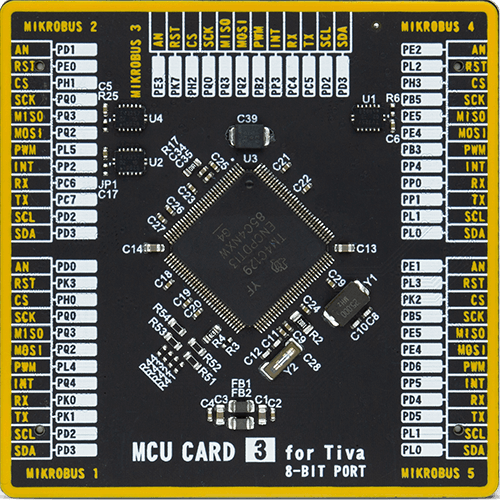
Type
8th Generation
Architecture
ARM Cortex-M4
MCU Memory (KB)
1024
Silicon Vendor
Texas Instruments
Pin count
128
RAM (Bytes)
262144
Used MCU Pins
mikroBUS™ mapper
Take a closer look
Click board™ Schematic

Step by step
Project assembly
Software Support
Library Description
This library contains API for FRAM 6 Click driver.
Key functions:
fram6_memory_write- This function writes a desired number of data bytes starting from the selected memory addressfram6_memory_read- This function reads a desired number of data bytes starting from the selected memory addressfram6_set_block_protection- This function sets the block protection bits of the Status register.
Open Source
Code example
The complete application code and a ready-to-use project are available through the NECTO Studio Package Manager for direct installation in the NECTO Studio. The application code can also be found on the MIKROE GitHub account.
/*!
* @file main.c
* @brief FRAM6 Click example
*
* # Description
* This example demonstrates the use of FRAM 6 Click board.
*
* The demo application is composed of two sections :
*
* ## Application Init
* Initializes the driver and performs the Click default configuration.
*
* ## Application Task
* Writes a desired number of bytes to the memory and then verifies that it's written correctly
* by reading from the same memory location and displaying the memory content on the USB UART.
*
* @author Stefan Filipovic
*/
#include "board.h"
#include "log.h"
#include "fram6.h"
#define DEMO_TEXT_MESSAGE "MikroE - FRAM 6 Click board"
#define STARTING_ADDRESS 0x01234
static fram6_t fram6;
static log_t logger;
void application_init ( void )
{
log_cfg_t log_cfg; /**< Logger config object. */
fram6_cfg_t fram6_cfg; /**< Click config object. */
/**
* Logger initialization.
* Default baud rate: 115200
* Default log level: LOG_LEVEL_DEBUG
* @note If USB_UART_RX and USB_UART_TX
* are defined as HAL_PIN_NC, you will
* need to define them manually for log to work.
* See @b LOG_MAP_USB_UART macro definition for detailed explanation.
*/
LOG_MAP_USB_UART( log_cfg );
log_init( &logger, &log_cfg );
log_info( &logger, " Application Init " );
// Click initialization.
fram6_cfg_setup( &fram6_cfg );
FRAM6_MAP_MIKROBUS( fram6_cfg, MIKROBUS_1 );
if ( SPI_MASTER_ERROR == fram6_init( &fram6, &fram6_cfg ) )
{
log_error( &logger, " Application Init Error. " );
log_info( &logger, " Please, run program again... " );
for ( ; ; );
}
if ( FRAM6_ERROR == fram6_default_cfg ( &fram6 ) )
{
log_error( &logger, " Default Config Error. " );
log_info( &logger, " Please, run program again... " );
for ( ; ; );
}
log_info( &logger, " Application Task " );
}
void application_task ( void )
{
uint8_t data_buf[ 128 ] = { 0 };
if ( FRAM6_OK == fram6_memory_write ( &fram6, STARTING_ADDRESS,
DEMO_TEXT_MESSAGE, strlen ( DEMO_TEXT_MESSAGE ) ) )
{
log_printf ( &logger, "Data written to address 0x%.5lx: \t%s\r\n", ( uint32_t ) STARTING_ADDRESS,
( char * ) DEMO_TEXT_MESSAGE );
}
if ( FRAM6_OK == fram6_memory_read ( &fram6, STARTING_ADDRESS,
data_buf, strlen ( DEMO_TEXT_MESSAGE ) ) )
{
log_printf ( &logger, "Data read from address 0x%.5lx: \t%s\r\n\n", ( uint32_t ) STARTING_ADDRESS,
data_buf );
Delay_ms ( 1000 );
Delay_ms ( 1000 );
Delay_ms ( 1000 );
}
}
int main ( void )
{
/* Do not remove this line or clock might not be set correctly. */
#ifdef PREINIT_SUPPORTED
preinit();
#endif
application_init( );
for ( ; ; )
{
application_task( );
}
return 0;
}
// ------------------------------------------------------------------------ END

























